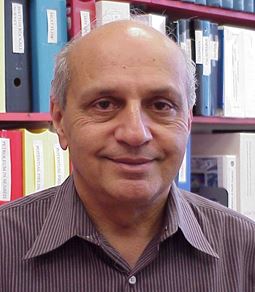Jan 19th-Potential Fields SIG: The Tectonic Origin of the Bay of Bengal and Bangladesh: A detective story*

Meeting Location:
HESS Club (Houston Engr. & Science Society)
5430 Westheimer
Houston, TX 77056
NOTE: You Must Be Logged In to Register
Speaker: Manik Talwani, Schlumberger Chair of Advanced Studies and Research Emeritus and Research Professor of Earth Science Rice University
We are able to unambiguously decipher the tectonic origin of the Bay of Bengal, a puzzle which has not been satisfactorily solved in the past and are also able to shed new light on the buried 85°E Ridge. We do so by incorporating a number of disparate items into a unified solution. These items are the marine magnetic anomalies in the Western Basin of the Bay of Bengal, the Rajmahal and Sylhet traps and Deep Seismic Sounding lines in India, a prominent magnetic anomaly doublet and seismic Seaward Dipping Reflectors in Bangladesh, and a new precise gravity map of the Bay of Bengal. The 85°E Ridge divides the Bay of Bengal into a Western and an Eastern basin. We identify seafloor spreading magnetic anomalies ranging in age from 132 Ma (M10n) to 124 Ma (M2) in the Western Basin. These anomalies are “one sided”, the conjugate anomalies lie in the Enderby Basin, off East Antarctica. The direction of spreading was approximately NW-SE, and the rate of spreading ranged from 4.2 to 3.0 cm/yr. With the arrival of the Kerguelen plume at around 118 Ma, sea floor spreading was reorganized and a new spreading axis opened at or close to the line joining the Rajmahal and Sylhet traps. The prominent magnetic anomaly doublet connecting the Rajmahal and Sylhet traps indicates that these traps are not individual eruptions, but rather, together, define the new line of opening. Spreading started at this line in a N-S direction as India moved northwards. The new oceanic crust, thus generated, underlies the Bangladesh and the Eastern Basin of the Bay of Bengal and is younger than 118 Ma. The western boundary of the new ocean floor is a transform boundary which was generated by the spreading axis jump. In part, it lies along the 85°E Ridge. A unique feature of the northern boundary of the new oceanic crust is that it lies on the continent, as opposed to all other ocean continent crustal boundaries in the world, which lie offshore.
Speaker Biography: Manik Talwani
Education and degrees
Delhi University, Physics B.Sc. (Honors) 1951
Delhi University, Physics M.Sc. 1953
Columbia University, Geophysics. Ph.D 1959
Oslo University, Norway, Ph.D.(Hon. Causa) 1981
Past Appointments:
President & CEO, Integrated Ocean Drilling Program-Management International, 2004 – 2009
Schlumberger Professor of Advanced Studies and Research, Rice University, 1985-2006
Director, Geotechnology Research Institute, Houston Advanced Research Center, 1985 - 1998
Chief Scientist, Gulf Research & Development Company, 1983-85
Director, Center for Marine Crustal Studies, Gulf Research & Development Company, 1981-1983
Director, Lamont-Doherty Geological Observatory, 1972-81
Professor of Geophysics, Columbia University, 1970-82
Research Scientist, Senior Research Associate, and Associate Professor, Lamont-Doherty Geological Observatory of Columbia University, 1959-70
Honors and awards:
From Asia
First KRISHNAN MEDAL, Indian Geophysical Union, 1965
EXEMPLAR OF EXCELLENCE, EXPLORER OF BRAHMA, Embassy of India, 1979
SACKLER DISTINGUISHED LECTURER, University of Tel Aviv, Israel, 1988
UNESCO TOKTEN AWARD National Institute of Oceanography, Goa, India, 1990
FOREIGN FELLOW, Geological Society of India, 2000
From Europe
HONORARY DOCTORATE of PHILOSOPHY, University of Oslo, Norway, 1981
FELLOW, NORWEGIAN ACADEMY OF ARTS AND SCIENCES, 1987
FOREIGN MEMBER, RUSSIAN ACADEMY OF NATURAL SCIENCES, 1992
ALFRED WEGENER MEDAL, European Union of Geoscience, 1993
LUDGER MINTROP AWARD, European Association of Geoscientists and Engineers, 2002
EMILE WIECHERT MEDAL, German Geophysical Society, 2009
From North America
MEMBER Sigma XI, 1960
Sixth JAMES B. MACELWANE AWARD, American Geophysical Union, 1967
FELLOW, AMERICAN GEOPHYSICAL UNION, 1971
NASA EXCEPTIONAL SCIENTIFIC ACHIEVEMENT AWARD, 1973 (Leader of team that sent gravity meter on APOLLO 17 mission to Moon.
GUGGENHEIM Fellowship, 1973-74
FULBRIGHT-HAYS Grant, 1973-74
FELLOW, AMERICAN ASSOCIATION FOR ADVANCEMENT OF SCIENCE, 1977
Sixth MAURICE EWING AWARD FOR LEADERSHIP IN OCEANOGRAPHY, American Geophysical Union and United States Navy, 1981
Second GEORGE P. WOOLLARD AWARD, Geological Society of America, 1984
HONORARY MEMBER, Houston Geophysical Society, 1993
MAURICE EWING MEDAL, Society of Exploration Geophysicists, 2015
Research Statement
I am engaged in a variety of research efforts. These include
1. Examining the potential application of a very sensitive gravity gradiometer to trace the leakage of CO2 sequestered in drill holes.
2. Studying the feasibility of increased use of enormous deposits of Venezuelan heavy oil.
3. Interpretation of San Andreas fault drill site gradiometer survey.
4. 85 East Ridge- a geologic enigma.
5. Study of the tectonic origin of the Bay of Bengal
Authorship
7 Books (edited) and more than 150 published articles in refereed journals.
Shipboard Expeditions
Led 25 shipboard expeditions. These included expeditions on research ships, on a British submarine and on a drillship.
5:30 Registration / Cash Bar
6:30 Dinner Served
7:30 Presentation Begins
8:30 Adjourn
Price List:
|
Pre-Registered |
Late/Walk-Up
|
Member
|
$30 |
$40 |
| Non-Member |
$35 |
$45 |
Student Member
|
$15 |
$25 |